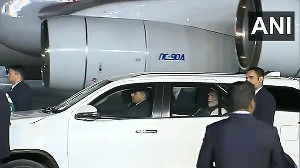The Nani starrer is an all-out, larger-than-life upgrade of the HIT series that loses steam in its attempts at stylistic indulgence, notes Arjun Menon.

Sailesh Kolanu has made a name for himself with the blockbuster HIT series that features individual crime procedural films that are stripped of the 'Indian mass movie' temptations, delivering basic genre pleasures.
These films have been an anomaly in the Telugu mainstream, where leading men as police officers usually represent a more populist sub-genre of masala cinema.
This series function more as episodic crime films expanded for a feature presentation with different actors playing the lead role in each film, with the director being the only constant presence.
HIT 3 sees Nani, who produced the first installment headlined by Vishwak Sen, and presented the second one featuring Adivi Sesh, finally starring as the lead in the third installment.
HIT 3 is heightened as opposed to its predecessors in terms of its story world and character design.
The titular Homicide Intervention Team this time around is headed by an enigmatic, trouble-seeker Arjun Sakaar (Nani), who is entrusted with a mysterious murder case in Jammu and Kashmir that finds its follow-up in different parts of the country.
The hero, as usual, puts together a team and begins to unravel the mystery, one revelation at a time.
The film places itself around the cop with anger issues and a mild midlife crisis hovering above his seemingly 'cool' ways of investigation.
The film is held together by Nani, who effortlessly carries the eccentricity and strange ways of the unusual investigator. The crime and its aftermath are all perfunctory at best, with monetary flourishes of good writing choices.
There is also a backstory that follows the hero, related to the murder that puts the whole investigation into action.
HIT 3 boasts of some great theatrical moments in its writing, and the violence and bloodshed set it apart from the earlier films.
The film approaches the central investigation as a dramatic device to offer more gruesome imagery, as the fuming hero has more reason to bash people's heads in due to his unruly temperament and high-jinx revelations thrown at him.
HIT 3 is more cinematic and larger-than-life by design, and you can sense Sailesh Kolanu upending the more realistic, stripped-down aesthetic of the first two films, for a more crowd-friendly model.
HIT 3 seems to be going for a completely different vibe with its heightened action and rousing screenplay moments.
The film is catering to a wider audience with multiple cameos and unexpected commercial cinema tropes that are integrated at several key plot points.
You can sense the HIT franchise morphing into a more popular cop franchise with bigger stakes.
Mickey J Meyer is aware of the mainstream iconography and uses his score as a means to heighten the dramatic punch.
Nani's star persona is captured in full glory by Cinematographer Sanu John Varghese. You get a sense of the style overtaking the written word at many moments.
Srinidhy Shetty doesn't get to do much and is confined to being an incidental romantic track that seems more like an afterthought.
But there is restraint in the way the fluff is integrated into the mix.
Samuthirakani, playing Nani's father, brings in some laughs with the oddball interactions with the hero. This is not a particularly grounded film for the performers to take centre stage, unlike the first two films, where each casting choice and character detail felt like important signifiers in the bigger picture.
Here, they are all there to support Nani's one-man army antics as mere placeholder figures. Even Prateik Babbar gets short-changed with an underwritten antagonist arc.
The slickness of the narrative and the genre shifts are done well but the film does not live up to Nani's commitment to all-out badass entertainment and just sets up punches without earning them.
The actor walks away with a larger-than-life performance that might be a treat to his fans.
As a star vehicle, HIT 3 makes logistics sense on paper but as a third installment of the franchise, the novelty doesn't make it anywhere nearly as interesting as the first two films.












